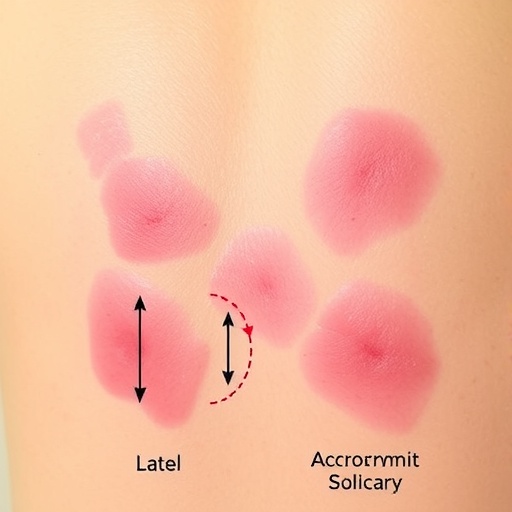In a significant and concerning development in pediatric dermatology, recent findings from a case study illuminate the complex nature of Acrodermatitis enteropathica, highlighting a rare and atypical presentation of this condition in a child. Traditionally known for its early-onset symptoms, this case presents a later onset accompanied by severe extensive dermatitis and a life-threatening progression that escalated to septic shock. The detailed examination shared by Foroughi et al. emphasizes the need for heightened awareness of this condition’s potential variations and underscores the urgency in addressing unusual presentations.
Acrodermatitis enteropathica, while often associated with zinc deficiency, can sometimes manifest in ways that challenge existing diagnostic frameworks. The child in this case, whose identity remains confidential for ethical reasons, displayed a symptomatology that diverged significantly from the classical characteristics typically outlined in medical literature. These symptoms included not only the expected skin lesions but also systemic complications that necessitated immediate and intense medical intervention.
For healthcare providers, recognizing the potential for atypical presentations is crucial, as early diagnosis and treatment can drastically alter outcomes. In this case, the child exhibited profound erythroderma that posed a risk of secondary infections and ultimately resulted in septic shock, a condition that is particularly concerning in pediatric populations. The manifestation of such extreme dermatological issues in combination with systemic symptoms prompts a reconsideration of the clinical signs that warrant suspicion of Acrodermatitis enteropathica.
The implications of this case extend beyond mere clinical observations; they reflect a broader pattern in pediatric dermatology where atypical presentations can often be overlooked. It serves as a poignant reminder of the necessity for clinicians to adopt a comprehensive approach to diagnosis, one that includes consideration of less common variants of known conditions. Such an approach could lead to improved survival rates and recovery outcomes for children affected by severe dermatological conditions.
Furthermore, the rapid progression to septic shock complicates the clinical picture and poses a significant challenge for medical professionals. This highlights the importance of multi-disciplinary care, where dermatologists, pediatricians, and infectious disease experts work collaboratively to manage such complex cases. This integrative approach is essential not just for treatment but also for the development of preventive strategies aimed at mitigating such dangerous complications.
The role of zinc in maintaining dermal health cannot be overstated, and deficiencies should remain a primary consideration in the differential diagnosis for pediatric skin conditions. However, this case also stresses the multifaceted nature of nutrition’s impact on overall health—particularly how deficiencies may manifest in various and unexpected ways. The child’s clinical course demonstrates how vital timely interventions are in addressing not just the symptomatology but also the underlying nutritional deficiencies contributing to the condition.
A careful review of the child’s medical history may reveal additional factors that could have contributed to this rare presentation. Pediatric patients may experience variances in diet, absorption, and overall health that traditional assessments might not fully encompass. Notably, the interplay between gastrointestinal issues and skin manifestations could suggest a more profound systemic condition that warrants further investigation beyond the typical scope of Acrodermatitis enteropathica.
As the healthcare community continues to learn from such case studies, the importance of awareness and education on the atypical presentations of dermatological diseases becomes increasingly apparent. Continued research into the variations of Acrodermatitis enteropathica and similar conditions is critical for developing improved diagnostic criteria and treatment protocols that better accommodate the diverse presentations seen in practice.
As this case study showcases, a deep understanding of the implications of dermatological illnesses extends to patient education and community awareness. Parents and caregivers must be informed about both typical and atypical indications of dermatological conditions to seek early intervention. This proactive approach can significantly reduce the risk of severe complications, such as septic shock, and lead to better health outcomes.
Moreover, the involvement of the medical community in acknowledging and addressing these atypical presentations will be paramount. By incorporating innovative research and adapting clinical practices, healthcare providers can ensure that they are prepared for a wide spectrum of symptoms, allowing for quicker and more accurate responses to complex pediatric cases.
In their conclusion, Foroughi et al. stress the necessity of vigilance in the pediatric healthcare community. The case not only illustrates the effects of a late-onset presentation of Acrodermatitis enteropathica but also underscores the critical need for ongoing research and education around this and other rare dermatological diseases. Such efforts will be integral in shaping a future where pediatric patients receive the comprehensive care they deserve.
In sum, this case study serves as a pivotal contribution to the understanding of Acrodermatitis enteropathica, particularly in its atypical manifestations. It invites a reevaluation of how pediatric dermatological conditions are assessed and treated, emphasizing the need for an open-minded and contemporary approach to medical diagnosis and patient care. Through sustained scholarly attention and practical application, the medical field can improve how it identifies and manages rare presentations, thus enhancing patient welfare and safety.
Subject of Research: Atypical presentation of Acrodermatitis enteropathica in a child.
Article Title: Atypical presentation of Acrodermatitis enteropathica in a child: later onset with life-threatening severe extensive dermatitis and septic shock.
Article References:
Foroughi, E., Abtahi-Naeini, B., Derakhshan, M. et al. Atypical presentation of Acrodermatitis enteropathica in a child: later onset with life-threatening severe extensive dermatitis and septic shock.
BMC Pediatr 25, 876 (2025). https://doi.org/10.1186/s12887-025-06208-0
Image Credits: AI Generated
DOI: 10.1186/s12887-025-06208-0
Keywords: Acrodermatitis enteropathica, pediatric dermatology, atypical presentation, zinc deficiency, septic shock, systemic illness.




